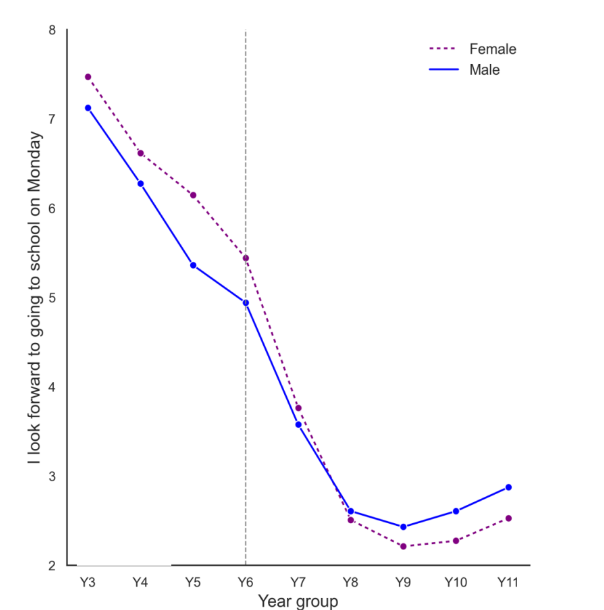


Please enjoy this free content - for more Need To Know articles please consider a subscription
Pupil absence is still significantly higher than pre-pandemic, and there are no quick fixes. Factors such as a sense of belonging, a positive classroom experience, and clear, consistent communications can all make a difference – but you need to dig into the data to identify the challenges for individuals and groups.
In the EEF resource Supporting school attendance, they identify six themes to support attendance strategy.
You can use their reflection and planning tool to dig into these areas and generate actions.
ImpactEd are continuing their research into attendance and shared insights in a webinar session, Understanding Attendance: From insight to action.
A key question they’ve used in surveys with pupils, ‘Are you looking forward to going to school on Monday?’, reveals the drop off in pupil motivation as they move up towards secondary school – and a ski-slope drop between years 7 and 8.

When understanding attendance, it’s important to look at specific stages and groups. Compare like with like: how does attendance this week/month compare with the same time last year? For this age or pupil group?
Be specific, targeted and granular.
Bear in mind that vulnerabilities (for example disadvantage and SEND) can have a cumulative impact.
Equally, providing for specific pupil needs (e.g. increasing your speech and language therapy provision) could have a positive impact on attendance over the long-term, as pupils feel more able to cope with the demands of school life or particular subjects.
For pupils in the bottom 20% of school attendance, often they're quite aware of the consequences of non attendance. The challenge is perhaps more fundamentally to deal with them feeling part of the school and motivated by education.
The ImpactEd research finds that rewards are more effective than sanctions.
David Astin, an executive principal in the Harris Federation, shared how taking a much more short-term approach to rewards has had a positive effect.
For example, rather than setting a target or reward for attendance over a term, go with a ‘if you’re in for the next 15 days, we’ll do X’. Make the rewards tangible and something pupils want. David shared how a free cookie at Friday break time was a remarkably popular incentive!
David Astin also spoke about identifying patterns and trends in pupil attendance behaviours, and using that to predict, inform action and affect change – and prevent habits from becoming entrenched.
For example, for persistently or severely absent pupils, they identified that Mondays were crucial: if a pupil was in on a Monday, it was much more likely they would then be in on Tuesday and Wednesday. So there’s a focus on getting pupils to school on Mondays.
If you want to find out more about the ImpactEd attendance project and/or take part in actionable research, express your interest.
Attendance is everybody's business. Whatever your role in school, you can contribute towards creating an inclusive environment where everyone feels welcomed and valued.
This might be in:
What particular areas can you take action in to affect attendance?
For an example of an all-round people strategy that supports a positive attendance culture, check out ASSET Education’s Complete Human Strategy.


































































































